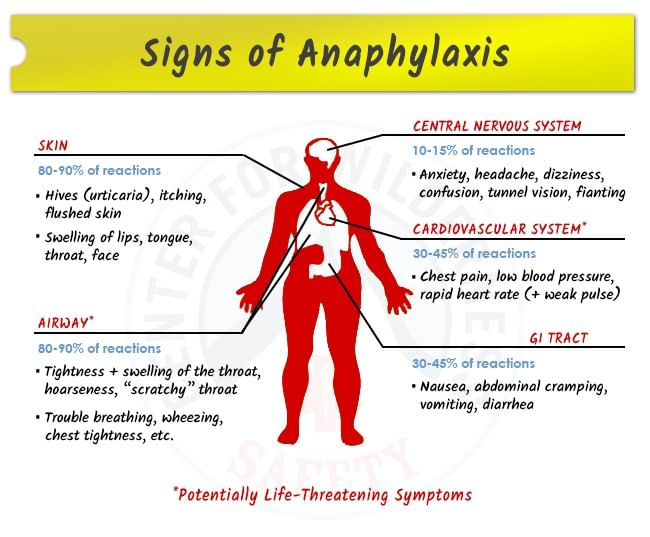Anaphylaxis - Know More About It!
Anaphylaxis Definition:
Anaphylaxis is a severe allergic reaction that can be life-threatening if not treated right away. It can occur on your body within no time. It generally occurs when you get exposed to something with which you have an allergy including bee stings or peanuts. Due to anaphylaxis, the immune system of a person can release a lot of chemicals that can cause the person to anaphylactic shock. Because of this, there can be a sudden drop in blood pressure, blockage in breathing, and airways can become narrow. Vomiting, weak or rapid pulse, nausea and a skin rash are some of the signs and symptoms of anaphylaxis. In order to treat anaphylaxis, a person needs an immediate injection of epinephrine or adrenaline. If adrenaline injection is not available, then the person should be taken to an emergency unit. Sometimes, it can be life-threatening if not treated properly on time.
Anaphylaxis Symptoms:
Symptoms of anaphylaxis can be noticed within some minutes of being exposed to an allergen. The symptoms can also appear around or after half an hour of the exposure to an allergen. Check out the various signs that may occur due to anaphylaxis:
- You can have various skin reactions due to anaphylaxis including itching, pale skin, and hives.
- Your airways can become narrow and throat or tongue can swell which can lead to trouble in breathing or can cause wheezing.
- Weak or rapid pulse is a common symptom of anaphylaxis.
- Anaphylaxis can lead to nausea, diarrhoea or vomiting.
- You may suffer from hypotension or low blood pressure due to this allergic reaction.
- You may have a feeling of fainting or dizziness in anaphylaxis.
Anaphylaxis Causes:
Anaphylaxis is a serious allergic reaction. Generally, this problem occurs in children due to an allergy from certain food items including fish, peanuts, milk, and shellfish. Besides all these food items, anaphylaxis can occur in adults due to various reasons including:
- There are some medicines that cause you anaphylaxis including aspirin, antibiotics and some over-the-counter medications.
- There are some imaging tests that use intravenous contrast IV that may lead to anaphylaxis.
- The allergy can occur due to proteins found in natural rubber latex may lead to anaphylaxis.
- Stings from yellowjackets, stings, fire ants, wasps, and hornets are also the causes of anaphylaxis
- It is not common but there is a possibility that people can get anaphylaxis from doing aerobics or exercises that may include jogging and even from the exercise which is less intense like walking. Some people can catch anaphylaxis if they eat certain food items before exercising in cold, humid or hot weather. You should talk to your doctor about the precautions that you need to take when you are exercising.
There are various tests that help to rule out the allergen that caused you an allergic reaction. Sometimes, the exact cause of anaphylaxis is not known.
How is it diagnosed?
As soon as you experience the symptoms or signs of anaphylaxis, you should visit the best doctor for the diagnosis as anaphylaxis is a serious problem and can threaten your life. Your doctor will do a physical examination and he or she will ask you about the previous history of allergic reactions. Your doctor will check from you if you are allergic to certain food items, insect stings, latex or some medicines. If you have a history of allergic reactions than there are chances that you will have a reaction in the future. Your doctor might ask you to go for some tests in order to be sure about the diagnosis. For this purpose, some skin or blood tests can be done. A test can be done in which you are exposed to a bit of thing that can be a reason for your allergy. Check out the various tests that can be done for the diagnosis:
- Allergy skin prick or scratch test: It is a common method used for testing an allergy. In this test, a small amount of substance is placed on your skin that has been suspected to be a reason for your allergy. After the placement of substance, your doctor pricks or scratches your skin in order to introduce the substance under your skin surface. Then the skin is closely noticed by your doctor for a reaction which can include redness or swelling.
- Percutaneous or intradermal testing: It is also a skin testing method used for confirming the presence of the disease. In percutaneous testing, a needle is introduced into the outer layers of the skin for injecting a drop of allergen and then the epidermis is lifted up gently. In intracutaneous testing, a small amount of allergen is injected into your dermis.
Others conditions can also have symptoms of anaphylaxis. Your doctor will do his or her best in order to find out other conditions too.
Prevention of Anaphylaxis:
It is a rare but serious allergy that can even threaten your life. This allergy can occur to you all of a sudden. Check out some of the ways that will help you to reduce the risk of anaphylaxis:
- Tell your friends and family about the substances with which you are allergic so that they do not mix those substances in the food that they cook for you.
- Grab your own food when you are going to some unknown place and you have no idea about their meal plan.
- Sometimes, allergy can also occur due to touching the food items with which you are allergic. Before grabbing a seat, you should be sure that the area around you is clean and does have any evidence of food that can give you an allergy.
- Check the ingredients of packaged food items before buying and make sure that they do not include the items with which you are allergic.
- You can wear a medical bracelet that alerts you about the allergies.
- If you are allergic to stings of insects then you should wear clothes that cover you completely whenever you go outside.
- Always keep epinephrine or adrenaline injection kits with you.
Treatment of Anaphylaxis:
Check out various treatment options that are available for the patients affected by anaphylaxis:
- Epinephrine or adrenaline: It is generally used as an initial drug in case of anaphylaxis. It is more effective when injected just after the exposure to an allergen. If not injected at the earliest then it can lead to complications even death. It is used to minimize the allergic response in your body.
- Cardiopulmonary resuscitation (CPR): It is an emergency procedure that can be used when you have an attack of anaphylactic due to which you are not able to breathe and your heart is not beating.
- Cortisone and intravenous (IV) antihistamines: These are used to minimize the inflammation or swelling in your air passages and also to help you in improving your breathing.
- Oxygen: If a patient affected by anaphylaxis is facing problem in breathing then oxygen may be given to the patient help in breathing.
- Beta-agonist (like albuterol): Your doctor may prescribe a beta-agonist (like albuterol) in order to relieve the symptoms related to breathing.
Complications
Check out the various complications that are associated with anaphylaxis:
- Anaphylactic shock: Sometimes people can have an allergic reaction to the exposure of insect sting, latex, medicine, and some food items. This can lead to anaphylaxis which is a life-threatening condition. Due to this, the immune system can release some chemicals that can flood the body resulting in anaphylactic shock.
- Other complications: Sometimes due to anaphylaxis, people stop breathing and they suffer from a blockage in air passages because of the inflammation or swelling of the air passages. You may also suffer from a heart attack due to anaphylaxis.
Myths related to Anaphylaxis
Check out various misconceptions that people have about anaphylaxis:
Myth #1: Anaphylaxis happens right away.
A lot of people think that anaphylaxis happens right away. But the reality is that it happens after a few minutes of exposure to an allergen including medication, insect sting, latex, and certain food items. There is also a possibility that you experience the symptoms of anaphylaxis around or after half an hour of exposure to an allergen. The symptoms can back sometimes even after the treatment. That is why a person should be admitted to the hospital so that he or she gets complete care for several hours.
Myth #2: Anaphylaxis can be treated with over-the-counter medicines.
The initial treatment that should be given in case of anaphylaxis is injections of epinephrine or adrenaline. It helps to raise your heartbeat and also open your air passages. This medicine is injected into the muscle of your upper thigh. If you are not sure about the symptoms then also you can use this as it would not cause you any harm even if it is not anaphylaxis. You can get these injectors on prescription only. You should always keep them with you. It is a serious problem, so it is important that you visit a hospital.
Myth #3: Epinephrine or adrenaline is not easy to inject.
Epinephrine or adrenaline is easy and safe to inject. You can do this on your own. People think that epinephrine has various side effects but there are very less. There is a possibility that may get nervous with the idea of using a needle. You should always keep the kits of auto-injector with you so that you can use it when required. You should ask your doctor about the right tips to use this injector.
Myth #4: It is easy to know the exact cause of anaphylaxis.
Anaphylaxis can occur due to an allergen that may include certain food items, medications, latex and insect sting. Various tests can be conducted to diagnose anaphylaxis. But sometimes it is not possible to know the exact cause of anaphylaxis. Such cases are known as idiopathic anaphylaxis. It is important that you visit the best doctor as soon as you discover the symptom as it is a fatal problem.
Conclusion
Anaphylaxis is a life-threatening reaction that can occur if you get exposed to something with which you are allergic. Itching, pale skin, hives, fainting, dizziness, low blood pressure, weak or rapid pulse and trouble in breathing are some of the symptoms of anaphylaxis. As soon as you experience the symptoms of anaphylaxis, you should visit a doctor for a diagnosis and treatment. Your doctor may conduct various blood and skin tests in order to diagnose anaphylaxis and provide you with treatment. Epinephrine or adrenaline is a drug that is used initially to treat the problem of anaphylaxis. You can inject epinephrine or adrenaline on your own. You should always keep the kits of adrenaline auto-injectors with you. You should cover yourself completely while going outside if you an allergy from the insect sting. Before eating anything outside, you should confirm that it does not include any item with which you are allergic. Anaphylactic shock is a major complication associated with anaphylaxis that can even lead to death if not treated properly on time or left untreated. It is important that you should visit a hospital for the treatment of anaphylaxis as it is a serious problem that requires proper care for several hours.



+1.svg)
